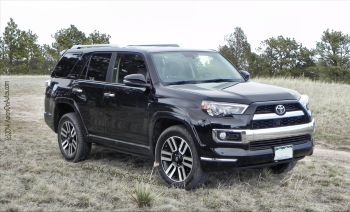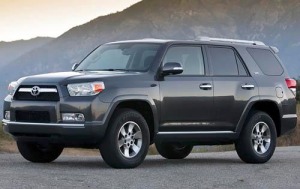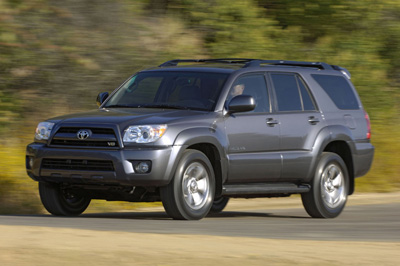Due to today's extremely overpriced used car market, many shoppers are now looking for "older" models that have aged well as a way to save significant dollars. The Toyota 4Runner is certainly one of these models, making them a viable and definitely more economical option at this time.

We're specifically referring to the fourth generation aas well as the earlier models from the fifth generation. That's where the largest potential savings are. And well below average annual mileage candidates can still be found out there.
We happen to think the 4Runner is one heck of an SUV ... and we're far from alone. It has become one of the most widely recognized SUV names on the planet, earning an outstanding reputation as rugged, tough and durable ... both off-road or on.
This is not to say an older Toyota 4Runner is immune to mechanical problems as it ages. All vehicles have them. It just means that for those on a tighter budget who want an older SUV that is more likely to be reliable and have a longer lifespan, carefully shopping for a well-maintained 4Runner could put the odds in their favor.
So here, ...
- We'll do an overview of some earlier Toyota 4Runner generations, specifically beginning with the 4th generation's 2003 model year.
- Then we'll list possible mechanical issues that have been reported by some owners for each generation, because all vehicles have them, so they can be checked before buying one today.
- And then we'll summarize the overall pros and cons of each generation worth consideration for potential buyers today.
But first, and very importantly ...
Things To Do When Considering An "Older" Vehicle
Locate Lower Mileage Vehicles: They are certainly out there to be found with careful and patient shopping. Be willing to drive a distance if you have to.
Vehicle History and Maintenance: Ask for the vehicle history report (CarFax or AutoCheck) as well as documented maintenance and repair records. If not provided by the Dealer or private seller, it's usually best to move on.
Pre-Purchase Inspection: Have the vehicle independently inspected before making a final decision. This usually will cost in the $200 range but is well worth it given the potentially thousands in savings over the long term.
And My #1 Price Tip: Please, always get online price quotes at auto sites such as CarsDirect.com and Edmunds.com (both, actually), whether looking for a new or used car. Competition among dealers for your business does amazing things to prices, and it's so easy. It really does make a difference.
And quickly, while we're at it, my #2 Tip is to always know the up-to-date trade-in value of your current car. You can get a quick and surprisingly accurate one at Edmund's Trade-In Quotes.
It's free and just takes a couple of minutes. I think what helps its accuracy is the inputs will include either your plate# or VIN# followed by many simple, but specific, yes/no questions. It really focuses in on the detail of the specific vehicle.
Fifth Generation Toyota 4Runner (2010- Present)

In this generation, the 4Runner's exterior look became edgier while the base engine returned to a four-cylinder for the first time since 2002. In addition, the V6 was tweaked for a power boost to 270 horsepower (up 34 hp) and 278 pound-feet of torque (up 12 lb-ft) without a sacrifice in fuel economy.
Built on the same platform as the rough-and-tumble FJ Cruiser, it's longer, wider and taller than the previous generation. And of course, it still sports its renowned solid rear axle for excellent off-road performance.
Also significant was the addition of the available Kinetic Dynamic Suspension System (KDSS) which can disconnect the front and rear stabilizer bars when driving under 40 mph for improved wheel articulation on rough terrain.
Changes during the early years of this production run have been minimal, although for 2011 the 2WD SR5's 2.7-liter inline-4 (157 hp and 178 lb-ft) as well as its four-speed automatic transmission were dropped. And 2012 saw the introduction of the optional Entune smartphone integration system.
And in 2014, this generation received a facelift, included revised front and rear fascias and other exterior cosmetic changes. In addition, the interior was also updated and new standard features were added, including an eight-way power driver’s seat, a leather-wrapped steering wheel and shifter, a roof rack, and Entune.
Models consist of SR5, Trail and Limited choices, all powered by a 4.0-liter V6 that's good for a healthy 270 horsepower and 278 pound-feet of torque that is paired with a five-speed automatic transmission. Both the SR5 and Limited come in rear-wheel and four-wheel drive versions (full-time on the Limited and part-time on the SR5). The Trail is only offered with part-time 4WD.
Typical standard features for the SR5 include full power accessories, skid plates, air-conditioning, alloy wheels, foglights, a tilt/telescoping steering wheel, cruise control, a power rear window and a CD/MP3 audio system.
The Trail adds features such as Bluetooth, a hood scoop, off-road tires, Crawl Control (automatically adjusts throttle and brakes when going up or down hills), a rearview camera, a locking rear differential and water-resistant upholstery.
The top-of-the-line Limited model goes on to add features such as leather upholstery, heated front seats, Toyota's X-REAS adaptive suspension dampers (controls body roll), dual-zone automatic climate control, keyless entry/ignition, an upgraded stereo system and Toyota's Entune smartphone integration system.
These 4Runners can also be found with options such as navigation, a third-row seat and the previously mentioned KDSS system.
2010 - Present Toyota 4Runner Possible Mechanical Problems
This generation generally has a solid reputation for reliability, and many owners report minimal mechanical problems. However, like any vehicle, it's not entirely free from potential issues. Here are some that have been reported that should therefore be checked before buying one today:
Suspension Components: Some owners have reported issues with suspension components, such as worn-out shocks or struts. This can lead to a less comfortable ride and reduced handling.
Water Pump Failure: In some instances, water pump failure has been reported. A malfunctioning water pump can lead to overheating and potential engine damage.
Car Buying Tips:
How To Get The Best Deal On A New Toyota
This One Tip Will Save Thousands On Car Insurance
The Best Used Cars For Gas Mileage
Exhaust System Issues: There have been reports of rust and corrosion on the exhaust system, particularly in areas with harsh weather conditions. This can lead to exhaust leaks.
Transmission Issues: While not extremely common, some owners have reported problems with the automatic transmission. This might include issues such as rough shifting or transmission fluid leaks.
Navigation and Infotainment System Problems: In earlier model years, there were occasional reports of issues with the navigation and infotainment systems, such as frozen screens or software glitches.
Rust Issues: In regions with heavy road salt use in winter, there have been reports of rust forming on certain components, particularly the undercarriage.
It's important to note that not all 4Runners will experience these issues, and Toyota has made improvements and addressed certain concerns with subsequent model years. Regular maintenance and timely repairs may have also contributed to the longevity and reliability of any vehicle.
Fifth Generation Toyota 4Runner Pros And Cons
2010 - Present Toyota 4Runner Pros
Off-Road Capability: The 4Runner is known for its off-road prowess, featuring a sturdy body-on-frame construction, available four-wheel drive, and advanced off-road technologies like the TRD (Toyota Racing Development) packages.
Reliability: Toyota has a reputation for producing reliable vehicles, and the 4Runner is no exception. Many owners report long-lasting durability and minimal issues.
Cargo Space: The 4Runner offers a spacious cargo area, especially with the rear seats folded down, making it suitable for hauling gear and luggage.
Towing Capacity: The 4Runner is capable of towing trailers and other recreational equipment, with towing capacities varying depending on the trim and equipment.
Value: Toyotas, in general, tend to hold their resale value well, and the 4Runner is no exception.
Interior Space: Generous cargo space, especially with rear seats folded down, spacious cabin.
Drive Quality: Stable and capable on various terrains, reliable and predictable handling.
Gas Mileage: Decent fuel efficiency for a body-on-frame SUV, especially on the highway.
Comfort: Comfortable seating for long trips, well-appointed interiors in higher trims.
Technology and Infotainment: Generally well-equipped with standard features like touchscreen displays, available with advanced safety features in higher trims.
Interior Quality: Well-built interior materials, especially in higher trims.
2010 - Present Toyota 4Runner Cons
Reliability: While generally reliable, like any vehicle, there can be occasional mechanical issues.
Fuel Efficiency: The 4Runner's fuel efficiency is generally lower compared to crossover SUVs due to its body-on-frame construction and larger engine options.
Ride Comfort: Some drivers find the ride to be somewhat firm, especially on rough or uneven surfaces. The suspension is designed for off-road capability, which can sacrifice a bit of on-road comfort.
Outdated Interior Technology: Depending on the model year, the 4Runner may lack some of the latest infotainment and safety features compared to more recently updated SUVs.
Limited Engine Options: The 4Runner typically comes with a V6 engine, and there may be a desire for more engine options, including more fuel-efficient alternatives.
Interior Space Utilization: While the 4Runner has a roomy cargo area, some users find the interior space utilization less efficient compared to other SUVs in its class.
Towing Capacity: Towing capacity might vary depending on the trim and equipment.
Interior Quality: Some plastic materials in lower trims might feel less premium.
Fourth Generation Toyota 4Runner (2003 - 2009)

There are still many used 4Runners available on the road right now from its fourth generation, which come in three trim levels: the SR5, Sport Edition and Limited.
All were equipped with either a 4.0-liter V6 engine rated at 245 horsepower and 282 lb-ft of torque, or a 4.7-liter V8 rated at 235 horsepower, but which produced a robust 320 lb-ft of torque. And all came with a four-speed automatic transmission in either rear-wheel drive or four-wheel drive form.
Beginning with the 2004 model year, a third row became an available option on SR5 and Limited models. In 2005, the V8's power was boosted to 270 horsepower and 330 lb-ft, and the V6 got a five-speed automatic transmission.
Even the base SR5 came already well-equipped with standard features such as full power accessories, cruise control, automatic climate control with rear vents and a trip computer. The Sport Edition comes with more than just an appearance package (roof rack, side steps, fog lights). It has larger front brakes, 17-inch wheels and an upgraded suspension system.
The top-of-the-line Limited adds leather upholstery, a CD changer (2006 and newer) and dual climate control.
Some of these older 4Runner models can also be found with the optional navigation system, which added a back-up camera for 2004. And all models have off-road electronic features such as Downhill Assist Control and Hill-Start Assist Control. And in 2005, the 4Runner got some modest exterior design revisions, while the stability control system added a limited-slip differential.
There were a few more styling revisions in 2006, while additional sound insulation material was also added. And the 2008 model year saw the previously optional side curtain airbags become a standard feature, while the 2009 model introduced a new optional trail edition package for enhanced off-road performance.
In terms of performance, this 4Runner generation is surprisingly smooth and quiet for a vehicle capable of so much rough and tumble. There's very little body roll and the V6 engine provides plenty of power, probably enough for most drivers ... except those with heavy hauling needs. And off-road ... well, the 4Runner really shines off-road.
2003 - 2009 Toyota 4Runner Possible Mechanical Problems
The fourth generation 4Runner also has a good reputation for reliability. However, like any vehicle, there have been reported issues and more common mechanical problems that owners have encountered and that therefore should be included in a pre-purchase inspection.
Timing Belt/Water Pump: Some owners reported issues with the timing belt and water pump. It's important to replace the timing belt at recommended intervals to avoid potential engine damage.
Transmission Fluid Leaks: There were occasional reports of transmission fluid leaks. Regular maintenance checks and addressing leaks promptly can help prevent more significant issues.
Ball Joint Wear: Wear and tear on front ball joints were reported by some owners. Regular suspension inspections can help identify and address these issues before they become severe.
Rust Issues: In regions with heavy road salt use, some 4Runners experienced rust issues, particularly on the undercarriage.
Exhaust System Corrosion: Corrosion on the exhaust system, especially in areas with harsh weather conditions, was reported. This can lead to exhaust leaks and affect performance.
Air Injection Pump Failure: Some owners reported problems with the air injection pump, leading to issues with emissions control.
Power Steering Fluid Leaks: Instances of power steering fluid leaks were reported.
Dashboard Cracking: In some models, especially those exposed to high temperatures, there were reports of dashboard cracking.
Fourth Generation Toyota 4Runner Pros And Cons
2003 - 2009 Toyota 4Runner Pros
Off-Road Capability: Like its predecessors, the fourth-generation 4Runner is known for its off-road capabilities.
Cars, The Unusual And Funny:
Reliability: Toyota has a reputation for building reliable vehicles, and the fourth-gen 4Runner is no exception. Many owners report longevity and minimal issues with proper maintenance.
Cargo Space: The 4Runner offers a spacious cargo area, especially with the rear seats folded down, making it suitable for hauling gear and luggage.
Towing Capacity: The 4Runner is capable of towing trailers and other recreational equipment, with towing capacities varying depending on the trim and equipment.
Resale Value: Toyota vehicles, including the 4Runner, tend to retain their resale value well over time.
Drive Quality: Stable and capable on various terrains, reliable and predictable handling.
Gas Mileage: Decent fuel efficiency for a body-on-frame SUV, especially on the highway.
Comfort: Comfortable seating for long trips, well-appointed interiors in higher trims.
Technology: Well-equipped with standard features like touchscreen displays, available with advanced safety features in higher trims.
Interior Quality: Well-built interior materials, especially in higher trims.
2003 - 2009 Toyota 4Runner Cons
Fuel Efficiency: The fourth-generation 4Runner is not known for its fuel efficiency, especially when compared to more car-like crossover SUVs. The body-on-frame construction and larger engine options contribute to this.
Ride Comfort: Some drivers find the ride to be somewhat firm, especially on rough or uneven surfaces. The suspension is designed for off-road capability, which can sacrifice a bit of on-road comfort.
Outdated Interior Technology: As this generation spans from 2003 to 2009, these earlier models may lack some of the latest infotainment and safety features seen in more recent SUVs.
Limited Third-Row Seating: The available third-row seating option may be cramped and less suitable for adults. It's generally more practical for occasional use or for children.
Limited Engine Options: This 4Runner comes with a V6 engine, and there may be a desire for more engine options, including more fuel-efficient alternatives.
Aging Design: Toward the end of its production in the mid-2000s, the design began to show its age compared to more modern SUVs.
Towing Capacity: Towing capacity might vary depending on the trim and equipment.
Reliability: While generally reliable, like any vehicle, there can be occasional mechanical issues.
Interior Quality: Some plastic materials in lower trims might feel less premium.
 By Josh Rosenberg
By Josh Rosenberg